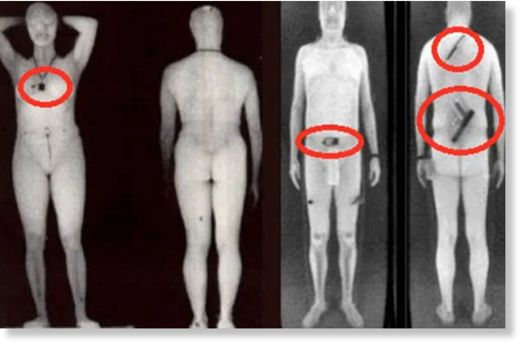
TSA Genital Scanners, and nothing more
Body scanners are a controversial tool that's currently being installed at airports worldwide -- particularly in the U.S., where the government has paid contractors such as Rapiscan and Brijot hundreds of millions of dollars to deploy over 500 of the devices. In the U.S. the deployment has reportedly been pushed by illicit financial ties, such as former U.S. Department of Homeland Security's (DHS) chief Michael Chertoff's financial relationship with Rapiscan, who
paid off the chief for his "consulting services."
Meanwhile, there have been reports of U.S. Transportation Safety Administration (TSA) officials abusing the devices to
make fun of peoples' genitals. And reports also
indicate health risks and the possibility that the DHS may be
storing nudes scans of people for later reference.
But the most damning piece of evidence against the scanners yet may have just landed, delivered by college-educated engineer Jonathan Corbett, who runs the blog "
TSA Out of Our Pants".
Mr. Corbett has identified a weakness in the device, which essentially renders them useless. He reasoned that both the older backscatter machines and the new millimeter wave scanners all relied on contrast with the body to "see" items, such as weapons or bomb-making chemicals. So he decided to see what happened if a secret pocket was stitched into a shirt, well off of the body.
He tested the theory using a metal case stored inside a secret pocket. Had he put the object in his chest pocket, it would have been spotted in the scans and he would almost certainly have been detained. But by using the secret side pocket, which was not contrasted against his body, he eluded both the Fort Lauderdale-Hollywood International Airport's backscatter machine and the Cleveland-Hopkins International Airport's newest millimeter wave machine.
He
comments to top UK news site Mail Online, "While I carried the metal case empty, it could easily have been filled with razor blades, explosives, or one of Charlie Sheen's infamous seven gram rocks of cocaine. With a bigger pocket, perhaps sewn on the inside of the shirt, even a firearm could get through."
The metal case would have been detected by the old security checkpoint of a decade ago, as it had metal-detectors. However, the new checkpoints largely have no built-in metal detection of on-person objects, relying solely on full-body scanners and occasional pat-downs (which Mr. Corbett did not receive).
Cleverly, Mr. Corbett video-taped his clean scan, by putting his camera, running, on the conveyor belt and allowing it to travel through luggage X-Ray scan, spotting him on his way out.
"Now, I'm sure the TSA will accuse me of aiding the terrorists by releasing this video, but it's beyond belief that the terrorists haven't already figured this out and are already plotting to use this against us. It's also beyond belief that the TSA did not already know everything I just told you, and arrogantly decided to disregard our safety. The nude body scanner program is nothing but a giant fraud."
In the past it was shown that less-dense objects like plastic guns or low-density explosives
could be missed in backscatter images. However, this is the first compelling proof that millimeter wave designs are also useless -- another prop in the government's expensive game of "security theater" -- a game that has been potentially motivated by financial corruption.
Mr. Corbett recalls thinking when he first envisioned the work-around, "It can't possibly be that easy to beat the TSA's billion dollar fleet of nude body scanners, right? The TSA can't be that stupid, can they?"
Summarizing his findings, he comments, "Unfortunately, they can, and they are."
The TSA has refused to comment on these developments.
simply because if they did they would have to admit that these stupid and costly machines are worthless......and those who manufacture them would lose big bucks. This flimflam machine usage, and that the TSA even exists, makes you wanna puke!!!!!